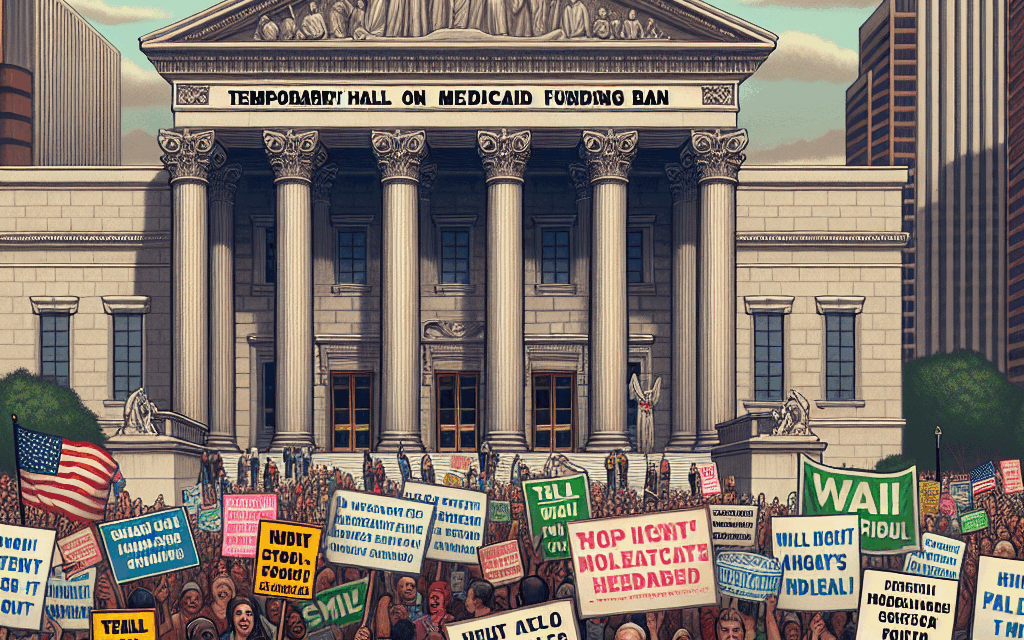Judge Issues Temporary Halt on Medicaid Funding Ban for Planned Parenthood in Megabill
The recent judicial decision to temporarily halt a Medicaid funding ban for Planned Parenthood has sparked significant debate across the United States. This ruling comes amidst a broader legislative context where healthcare funding, reproductive rights, and political maneuvering intersect. In this article, we will explore the implications of this ruling, the legal arguments surrounding it, the political landscape, the impact on healthcare access, and the future of reproductive rights in America.
Understanding the Legal Context
The legal battle over Medicaid funding for Planned Parenthood is rooted in complex interpretations of federal and state laws regarding healthcare funding and reproductive rights. The recent ruling by a judge to temporarily halt the funding ban is a significant development in this ongoing legal saga.
Medicaid, a joint federal and state program, provides health coverage to low-income individuals, including women who rely on it for reproductive health services. Planned Parenthood, as a major provider of these services, has been at the center of legal disputes regarding its eligibility for Medicaid funding. The crux of the issue lies in whether states can impose restrictions on Medicaid funding based on the type of services provided by healthcare organizations.
In many states, lawmakers have attempted to defund Planned Parenthood by arguing that the organization provides abortions, which they claim should disqualify it from receiving Medicaid funds. However, federal law, specifically the Medicaid Act, prohibits states from denying funding to qualified providers based solely on the services they offer. This legal framework has been challenged in various courts, leading to a patchwork of rulings across the country.
In this case, the judge’s decision to issue a temporary halt on the funding ban reflects a recognition of the legal protections afforded to Medicaid recipients and providers. The ruling emphasizes that states cannot selectively defund organizations that provide essential health services, including cancer screenings, STI testing, and contraceptive services, simply because they also provide abortion services.
The Political Landscape Surrounding Planned Parenthood
The political context of the Medicaid funding ban for Planned Parenthood is deeply intertwined with broader debates over reproductive rights in the United States. The organization has become a focal point for both pro-choice and pro-life advocates, leading to intense political battles at both state and federal levels.
In recent years, several states have enacted laws aimed at defunding Planned Parenthood, often citing moral or ethical objections to abortion. These legislative efforts have been met with fierce opposition from reproductive rights advocates, who argue that such measures disproportionately affect low-income women who rely on Planned Parenthood for essential health services.
Key political players in this debate include:
- State Legislators: Many Republican-led states have pushed for defunding measures, often framing them as a way to redirect funds to “better” healthcare providers.
- Advocacy Groups: Organizations like the American Civil Liberties Union (ACLU) and Planned Parenthood Federation of America have actively fought against these funding bans, arguing they violate federal law.
- Federal Government: The Biden administration has taken steps to protect Medicaid funding for Planned Parenthood, reversing many of the policies implemented during the Trump administration.
The political ramifications of the judge’s ruling are significant. It not only provides a temporary reprieve for Planned Parenthood but also sets a precedent for future legal challenges against similar funding bans. As the 2024 elections approach, the issue of reproductive rights and healthcare access is likely to remain a pivotal topic, influencing voter sentiment and legislative agendas.
Impact on Healthcare Access for Low-Income Women
The implications of the Medicaid funding ban for Planned Parenthood extend far beyond the organization itself; they directly affect healthcare access for millions of low-income women across the country. Planned Parenthood serves as a critical provider of reproductive health services, including family planning, cancer screenings, and STI testing.
According to the Guttmacher Institute, nearly 1 in 5 women in the United States have relied on Planned Parenthood for healthcare services at some point in their lives. For many low-income women, Planned Parenthood is often the only healthcare provider they can access due to financial constraints and geographic barriers.
When states impose funding bans on organizations like Planned Parenthood, the consequences can be dire:
- Reduced Access to Services: Women may face longer wait times or be forced to travel greater distances to access essential health services.
- Increased Health Risks: Lack of access to preventive care can lead to undiagnosed health issues, including cancers and sexually transmitted infections.
- Financial Burden: Women may be forced to pay out-of-pocket for services they previously received at low or no cost, creating additional financial strain.
Research has shown that when access to reproductive health services is restricted, rates of unintended pregnancies and maternal mortality can increase. A study published in the American Journal of Public Health found that states with more restrictive abortion laws also experienced higher rates of maternal mortality. This underscores the importance of maintaining access to comprehensive reproductive healthcare services.
Case Studies: States with Funding Bans
To better understand the impact of Medicaid funding bans on Planned Parenthood, it is essential to examine specific case studies from states that have attempted to implement such measures. These examples illustrate the varied outcomes and legal challenges that have arisen in response to funding restrictions.
Texas
In Texas, lawmakers passed a law in 2011 that aimed to defund Planned Parenthood and other organizations that provide abortion services. The state sought to redirect Medicaid funds to other healthcare providers, claiming that these providers would offer better alternatives. However, the result was a significant reduction in healthcare access for low-income women.
After the funding ban was implemented, a study by the Texas Policy Evaluation Project found that the number of women receiving care at family planning clinics dropped by 50%. This decline was accompanied by an increase in unintended pregnancies and a rise in the number of women seeking abortions. The state ultimately faced legal challenges, and in 2017, a federal court ruled that Texas could not exclude Planned Parenthood from its Medicaid program.
Indiana
Indiana’s experience with defunding Planned Parenthood provides another illustrative case. In 2011, the state passed a law that prohibited Medicaid funds from going to any entity that provides abortions. This law was met with immediate legal challenges, and in 2018, a federal court ruled that the law was unconstitutional, stating that it violated the Medicaid Act’s provisions regarding provider choice.
The court’s decision highlighted the importance of ensuring that Medicaid recipients have access to a range of healthcare providers, including those that offer abortion services. The ruling also reinforced the idea that states cannot impose restrictions that limit access to essential health services based on political or ideological beliefs.
Ohio
Ohio has also attempted to defund Planned Parenthood through various legislative measures. In 2016, the state passed a budget that included provisions to cut funding for organizations that provide abortions. This move was met with swift legal action, and in 2019, a federal judge ruled that Ohio’s funding ban was unconstitutional, emphasizing that it violated the rights of Medicaid recipients to choose their healthcare providers.
These case studies illustrate the challenges and consequences of funding bans on organizations like Planned Parenthood. They also highlight the resilience of legal protections for reproductive health services and the ongoing struggle for access to comprehensive healthcare in the United States.
The Future of Reproductive Rights in America
The temporary halt on the Medicaid funding ban for Planned Parenthood raises important questions about the future of reproductive rights in America. As legal battles continue and political landscapes shift, the fate of organizations like Planned Parenthood hangs in the balance.
Several factors will influence the trajectory of reproductive rights in the coming years:
- Judicial Appointments: The composition of federal and state courts will play a crucial role in shaping the legal landscape for reproductive rights. Appointments made by current and future administrations will impact how laws are interpreted and enforced.
- Public Opinion: As public sentiment around reproductive rights evolves, lawmakers may be compelled to reconsider their positions on funding bans and access to healthcare services.
- Advocacy Efforts: Continued advocacy from reproductive rights organizations will be essential in fighting against restrictive laws and ensuring that women have access to comprehensive healthcare services.
The recent judicial ruling serves as a reminder of the ongoing struggle for reproductive rights in America. It highlights the importance of legal protections for healthcare access and the need for continued vigilance in defending these rights against political and ideological challenges.
Conclusion
The temporary halt on the Medicaid funding ban for Planned Parenthood represents a significant victory for reproductive rights advocates and underscores the importance of access to comprehensive healthcare services. As legal battles continue and political landscapes shift, the future of reproductive rights in America remains uncertain.
Through examining the legal context, political landscape, impact on healthcare access, case studies, and future implications, it is clear that the fight for reproductive rights is far from over. The recent ruling not only protects Planned Parenthood’s ability to provide essential services but also reinforces the principle that states cannot impose restrictions that limit access to healthcare based on political or ideological beliefs.
As we move forward, it is crucial for advocates, lawmakers, and the public to remain engaged in the conversation surrounding reproductive rights and healthcare access. The stakes are high, and the outcomes will have lasting implications for millions of women across the country.





